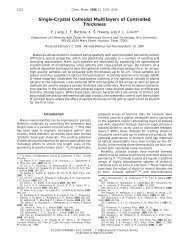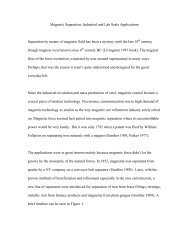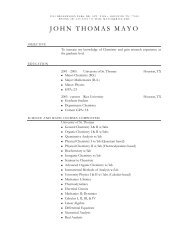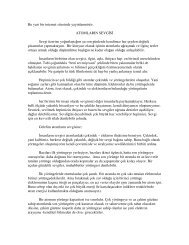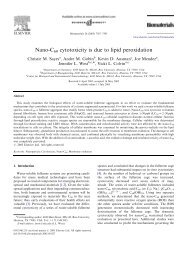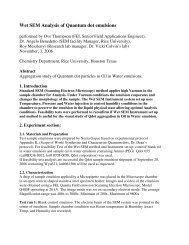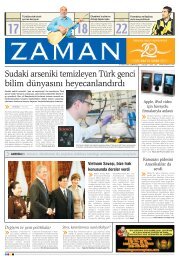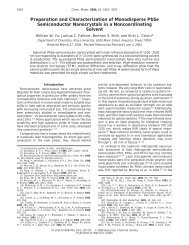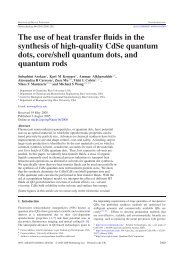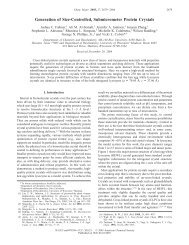Hydrothermal Synthesis of Quartz Nanocrystals - Rice University
Hydrothermal Synthesis of Quartz Nanocrystals - Rice University
Hydrothermal Synthesis of Quartz Nanocrystals - Rice University
You also want an ePaper? Increase the reach of your titles
YUMPU automatically turns print PDFs into web optimized ePapers that Google loves.
<strong>Hydrothermal</strong> <strong>Synthesis</strong> <strong>of</strong> <strong>Quartz</strong><br />
<strong>Nanocrystals</strong><br />
Jane F. Bertone, Joel Cizeron, Rajeev K. Wahi, Joan K. Bosworth, and<br />
Vicki L. Colvin*<br />
Department <strong>of</strong> Chemistry, <strong>Rice</strong> UniVersity, 6100 Main Street, Houston, Texas 77005<br />
Received October 18, 2002; Revised Manuscript Received December 6, 2002<br />
ABSTRACT<br />
This paper describes for the first time a chemical method for the preparation for nanocrystalline quartz. Submicron quartz powders are<br />
initially produced in hydrothermal reactions where soluble silica precursors precipitate as pure crystalline silica. To yield nanocrystalline<br />
material these particles can be purified and size selected by dialysis, filtration, and centrifugation. Transmission electron microscopy and<br />
X-ray diffraction illustrate that the product is pure phase r-quartz, consisting <strong>of</strong> isolated (i.e., nonaggregated) nanocrystals. Depending on the<br />
size selection method, crystallites with average sizes <strong>of</strong> 10 to 100 nanometers can be recovered.<br />
In nature, quartz is the primary form <strong>of</strong> silicon and oxygen,<br />
elements that together comprise over 70% <strong>of</strong> the earth’s<br />
crust. 1 Its properties have been <strong>of</strong> great interest to geologists<br />
for decades, and its superior electrical and thermal insulating<br />
properties find applications in many industries. 2-5<br />
Given the widespread importance <strong>of</strong> quartz in nature and<br />
technology, it is remarkable that there are no reported<br />
chemical routes for the production <strong>of</strong> nanoscale quartz. Such<br />
a material would have a range <strong>of</strong> potential uses. The phase<br />
behavior <strong>of</strong> quartz nanocrystals could provide insight into<br />
the fundamental mechanisms responsible for solid-state<br />
amorphization and the R- transition, and their solution<br />
phase properties would be a valuable model for rock<br />
erosion. 6-11 Nanoquartz might also exhibit nanoscale piezoelectric<br />
behavior, which could be applied in small-scale<br />
actuators and motors. These and other potential applications<br />
motivated us to develop a solution-phase route to form<br />
nanoquartz.<br />
<strong>Quartz</strong> possesses features that make a purely chemical<br />
approach to its nanoscale formation challenging. First, the<br />
amorphous state <strong>of</strong> silica is nearly equal in energy to that <strong>of</strong><br />
R-quartz. 12 Thus, the common nanochemical strategy <strong>of</strong><br />
employing rapid decomposition <strong>of</strong> molecular precursors to<br />
form crystallites generally fails since the resulting product<br />
is amorphous. Second, the ideal prescription for nanocrystal<br />
formation, fast nucleation followed by slow growth, is<br />
difficult to implement in the case <strong>of</strong> quartz due to its<br />
extremely rapid growth rate in conditions required for its<br />
nucleation (80 nm/sec at 263 °C in 0.5 M NaOH). 13,14 This<br />
rapid growth rate also makes size control problematic.<br />
For these reasons, our strategy relies on both chemical as<br />
well as physical methods to form nanocrystalline quartz. 15<br />
* Corresponding author. E-mail: colvin@rice.edu<br />
10.1021/nl025854r CCC: $25.00 © 2003 American Chemical Society<br />
Published on Web 03/27/2003<br />
NANO<br />
LETTERS<br />
2003<br />
Vol. 3, No. 5<br />
655-659<br />
We conduct our reactions under hydrothermal conditions<br />
where bulk quartz is known to precipitate from aqueous<br />
solutions saturated with silica. <strong>Hydrothermal</strong> reactions have<br />
been successful at producing other nanocrystalline oxides<br />
such as TiO2 and BaTiO2, and recent reports have highlighted<br />
hydrothermal synthesis <strong>of</strong> micron sized quartz powders. 8,16-21<br />
Taking these as a starting point, we use high surface area<br />
silica precursors and perform the reaction under basic<br />
conditions in order to accelerate the quartz nucleation<br />
rate. 22-28 The resulting submicron powders can be subjected<br />
to simple purification processes which allow for nanocrystal<br />
samples <strong>of</strong> varying average sizes to be generated.<br />
This reaction starts with the hydrothermal dissolution and<br />
reprecipitation <strong>of</strong> silica under conditions designed to encourage<br />
rapid nucleation <strong>of</strong> quartz. In a typical reaction, 3.5 g <strong>of</strong><br />
a dry amorphous silica precursor is added to 100 mL 0.1 M<br />
NaOH in a Parr 4550 minireactor and ramped at 6 °C/min<br />
to 200-300 °C (see Supporting Information for detailed<br />
reaction procedures). Most <strong>of</strong> the reactions reported here use<br />
fumed silica as the starting material (99.8%, 390 m 2 /g,<br />
Sigma), though amorphous colloidal silica gives equivalent<br />
results. Both <strong>of</strong> these silica sources have high surface areas<br />
which result in rapidly rising soluble silica levels in the<br />
reactor. This coupled with strong basic conditions favors<br />
quartz nucleation.<br />
After 2 h, the starting product has dissolved and the<br />
reaction is quenched to 70 °C in 10-15 min by water<br />
circulation through the internal reactor cooling loop. A white<br />
powder (90% yield) can be recovered and purified by<br />
dialysis. It is crucial during dialysis to maintain a slightly<br />
basic pH (∼8). More basic solutions will favor the dissolution<br />
<strong>of</strong> solid phases <strong>of</strong> silica and may reduce the quartz yield. 29<br />
Even slightly acidic solutions are known to promote the
Table 1. Phases Observed under Different Conditions<br />
precursor T (°C) time product<br />
F a 300 1 h 20 min s b Q c<br />
F 250 5 hr WdQ<br />
F 200 40 hr C e ,wQ<br />
S f 300 1 h 30 min sQ<br />
F-ethanol 200 12 hr amorph<br />
a fumed silica. b strong. c quartz. d weak. e cristobalite. f Stöber silica.<br />
Figure 1. (A) TEM <strong>of</strong> the unfiltered product. (B) Selected area<br />
electron diffraction (SAED) pattern for the same type <strong>of</strong> sample.<br />
The rings indicated match to known quartz reflections. The reaction<br />
conditions are 3.5 g fumed silica for 2hat300°C in 100 mL<br />
0.1M NaOH.<br />
coagulation <strong>of</strong> unreacted and amorphous particles which clog<br />
filters and aggregate the product. 30 <strong>Quartz</strong> precipitation<br />
occurs after time periods <strong>of</strong> 5horless when the reaction<br />
temperature is above 250 °C and the concentration <strong>of</strong> NaOH<br />
is 0.1 M. Table 1 shows that the solid product is pure phase<br />
quartz only over a narrow range <strong>of</strong> reaction conditions. As<br />
observed in the formation <strong>of</strong> large single crystals <strong>of</strong> quartz,<br />
lower temperatures and more neutral pH conditions result<br />
in unreacted amorphous product, the formation <strong>of</strong> cristobalite,<br />
or complex silicate phases. 31-33<br />
The quartz powders produced by this reaction contain<br />
submicron crystallites with a wide distribution <strong>of</strong> particle<br />
sizes (Figure 1). The product, after 2 h at 300 °C, is<br />
composed <strong>of</strong> many large faceted particles, some aggregates,<br />
and many smaller, nanometer scale solid particles that are<br />
relatively isolated (Figure 1A). Selected area electron diffraction<br />
(SAED) (Figure 1B) shows spots from single-crystal<br />
diffraction as well as faint rings from powder diffraction that<br />
Figure 2. Reaction evolution. (A) SiO2 phase evolution by X-ray<br />
diffraction (XRD) <strong>of</strong> samples quenched at different reaction times.<br />
The time <strong>of</strong> sampling is listed in minutes at the right <strong>of</strong> each pattern.<br />
Reflections marked by diamonds can all be indexed to R-quartz.<br />
No R-quartz reflections are absent. All reaction conditions were<br />
identical to those in Figure 1. (B) Concentration <strong>of</strong> dissolved silica<br />
derived from the absorbance <strong>of</strong> monomeric Si(OH)4 complexed with<br />
molybdic acid (see Experimental Section in Supporting Information<br />
for more details). The error is 10% <strong>of</strong> [Si(OH)4] as indicated by<br />
the bar on the last data point.<br />
can be indexed, in agreement with X-ray diffraction (XRD)<br />
(Figure 2A), to the expected reflections for quartz. <strong>Quartz</strong><br />
powders are atomically pure as determined by energydispersive<br />
X-ray analysis (0.1 at. % Ti, 0.08 at. % Fe, 0.36<br />
at. % Ni, and 0.13 at. % Cu). It is useful to acknowledge<br />
that though the goal <strong>of</strong> this investigation is production <strong>of</strong><br />
nanoscale samples, this synthesis is one <strong>of</strong> few to report on<br />
quartz powders in the submicron length scale. 19-21<br />
As apparent in Figure 1A, nanocrystalline material comprises<br />
only a small fraction <strong>of</strong> the final quartz product; to<br />
assess whether nanocrystals were a major product at any time<br />
during the reaction we evaluated the time dependent growth<br />
<strong>of</strong> these particles (Figure 2). 15 Initially, a broad reflection<br />
characteristic <strong>of</strong> amorphous silica is observed (Figure 2A,<br />
bottom). During these early reaction times the soluble silica<br />
concentration steadily rises as the solid amorphous precursor<br />
dissolves (Figure 2B). After 70-90 min, when soluble silica<br />
656 Nano Lett., Vol. 3, No. 5, 2003
levels exceed 10 mg/mL, a narrow quartz reflection (superimposed<br />
on broader amorphous silica features) becomes<br />
visible at 26.65°. The width <strong>of</strong> this peak can be measured<br />
and from it a Scherrer fit is used to determine an average<br />
grain size <strong>of</strong> 31 nm. 34<br />
An additional 10 min <strong>of</strong> reaction produces powders that<br />
generate strong quartz patterns with over eight matching<br />
reflections (Figure 2A, 2nd from top). At this point the<br />
diffraction peaks are narrowed to the instrumental resolution<br />
limit and grain size analysis from such data is not feasible.<br />
These results illustrate that reaction quenching to limit<br />
crystallite size (such as extensive dilution after a brief period<br />
<strong>of</strong> nucleation) is not a productive strategy for nanocrystalline<br />
quartz. Quenched products contain significant fractions <strong>of</strong><br />
amorphous silica as evidenced by the broad peaks in the<br />
X-ray diffraction data (Figure 2A). Also, with quartz growth<br />
rates <strong>of</strong> ∼10 nm/second at the onset <strong>of</strong> nucleation, the<br />
separation <strong>of</strong> nucleation and growth does not occur in this<br />
reaction and thus crystals <strong>of</strong> very small size are only a small<br />
fraction <strong>of</strong> the product.<br />
We run this reaction to near completion and use filtration<br />
and centrifugation to recover quartz nanocrystalline fractions.<br />
After dialysis, up to six different samples are combined and<br />
concentrated 8× by rotary evaporation. The samples are<br />
initially filtered over coarse filter paper (Whatman 541,<br />
Fisher Scientific) and then over a glass fiber prefilter<br />
(Millipore AP15, Fisher Scientific). The retentate from the<br />
glass filter yields fraction 1; the filtrate is then further sizeselected<br />
by filtration over a 1.2 µm pore size nylon filter<br />
(Osmonics, Fisher Scientific) to give fraction 2. To yield<br />
smaller nanocrystals, these solutions are centrifuged for 2<br />
min at 3313 G. The supernatant after this process provides<br />
a suspension <strong>of</strong> nanoquartz crystallites referred to as fraction<br />
3. Fraction 4, the smallest fraction, is the supernatant after<br />
filtration over a 0.2 µm nylon filter (Osmonics) and<br />
centrifugation for 8 min at 3313 G. When such crystallites<br />
are in solution they are stable to sedimentation, colorless,<br />
and clear. In addition, when dried on a flat surface, the<br />
particles form a colorless clear thin film.<br />
We found the combination <strong>of</strong> centrifugation and filtration<br />
to be necessary for reliable and efficient separations. Filtration<br />
alone is insufficient to produce reasonable size distributions<br />
because filter membranes do not provide strict cut<strong>of</strong>fs<br />
in size. Also, filters with very small pore sizes (0.025 µm,<br />
Millipore) tend to become clogged during filtration, which<br />
prohibits cake redispersal. Centrifugation alone is ineffective<br />
due to the breadth <strong>of</strong> the initial size distribution. By<br />
combining both techniques we were able to achieve the most<br />
efficient separation <strong>of</strong> smallest nanoquartz with no contamination<br />
from larger particles.<br />
Transmission electron microscopy (TEM) illustrates that<br />
these size selection methods provide at least three different<br />
fractions <strong>of</strong> submicron to nanoscale R-quartz. Figure 3 shows<br />
the TEM data from both the supernatant (panel B) and pellet<br />
(panel A) <strong>of</strong> a sample that has been dialyzed, prefiltered,<br />
concentrated, and filtered over a 0.2-µm nylon membrane.<br />
This additional purification is able to remove large particles<br />
(>50 nm) as well as aggregates. Analysis <strong>of</strong> over 150<br />
Figure 3. Size selection <strong>of</strong> quartz crystallites. (A) Transmission<br />
electron micrograph (TEM) <strong>of</strong> the redispersed pellet from a sample<br />
after it was dialyzed, prefiltered, concentrated, filtered over a 0.2<br />
µm nylon membrane and centrifuged for 8 min at 3313 G (B)<br />
Fraction 4-the supernatant from the sample in panel A. (C) Selected<br />
area electron diffraction (SAED) Fraction 4. All reaction conditions<br />
were identical to those in Figure 1.<br />
particles from TEM images allows us to determine the<br />
particle size distribution <strong>of</strong> the materials resulting from our<br />
separation procedures (Figure 4). The average size <strong>of</strong> each<br />
fraction decreases considerably from 440 nm in the largest<br />
samples to 18 nm in the smallest. Size distributions improve<br />
as particle sizes decrease, reaching 28% in the smallest<br />
fraction.<br />
To verify that the small particles imaged in TEM were<br />
indeed R-quartz, we performed small area electron diffraction.<br />
The SAED results <strong>of</strong> these materials show rings, rather<br />
than spots, as expected for nanocrystalline samples; additionally,<br />
four quartz reflections were matched in the data (Figure<br />
3C). High-resolution TEM images <strong>of</strong> nanocrystals can be<br />
found in the Supporting Information; they were less informative<br />
than the SAED in confirming the presence <strong>of</strong> quartz.<br />
<strong>Quartz</strong> has poor contrast in TEM due to its low electron<br />
density. Additionally, it is very sensitive to beam damage<br />
Nano Lett., Vol. 3, No. 5, 2003 657
Figure 4. Sizing by TEM. Measurements were taken on the longest<br />
axis <strong>of</strong> at least 150 isolated particles. (A) Fraction 1 (retained from<br />
glass fiber prefilter) has an average size <strong>of</strong> 440 ( 228 nm. (B)<br />
Fraction 2 (filtered through 1.2 µm nylon paper, pellet after 20<br />
min at 3313 G) has an average size <strong>of</strong> 84 nm and a size distribution<br />
from 1 to 175 nm. (C) Fraction 3 (filtered through 1.2 µm nylon<br />
paper, supernatant after 2 min at 3313 G) has an average size <strong>of</strong><br />
37 nm and a distribution from 1 to 83 nm. (D) Fraction 4 (the<br />
same sample as Figure 3B; filtered through 0.2 mm nylon paper,<br />
supernatant after 8 min at 3313 G) has an average size <strong>of</strong> 18 nm (<br />
5 nm. Reaction conditions were identical to Figure 1. All samples<br />
were dialyzed, concentrated and coarse paper filtered. Fractions<br />
2-4 were also filtered over a glass fiber prefilter prior to further<br />
filtration as above.<br />
in electron microscopes, forming silicon quite readily. 35-37<br />
We found that the d spacing <strong>of</strong> the planes in high resolution<br />
images matched equally well to silicon as they did to quartz.<br />
We also found a weak reflection in the SAED that indexed<br />
to the Si 100 planes, but no evidence <strong>of</strong> silicon in X-ray<br />
diffraction data.<br />
X-ray diffraction collected using a synchrotron X-ray<br />
source confirms the presence <strong>of</strong> nanocrystalline quartz.<br />
Samples were dried for synchrotron powder XRD, and the<br />
resulting reflections exhibit line broadening. The line widths<br />
for the (100) and (101) reflections <strong>of</strong> quartz are broadened<br />
considerably (Figure 5) in the smaller samples, to 0.18 and<br />
0.20 degrees, respectively, as compared to the larger fractions<br />
in which peaks are narrowed to the instrumental resolution<br />
limit <strong>of</strong> 0.08 degrees measured using LaB6 (NIST standard).<br />
Scherrer analysis <strong>of</strong> the d100 peaks finds a grain size <strong>of</strong> 28<br />
nm for fraction 3. The reasonably good agreement between<br />
this grain size and the statistical particle size (37 nm)<br />
determined by TEM shown in Figure 4 is evidence that these<br />
small particles are indeed nanocrystalline quartz. Additionally,<br />
the agreement between the TEM and XRD grain size<br />
determinations suggests that particle defects and grain<br />
boundaries are not extensive in these materials. An analysis<br />
<strong>of</strong> this X-ray diffraction data, and its changes under pressure,<br />
are the subject <strong>of</strong> another publication. 38<br />
In this approach to forming nanoscale quartz, we sacrifice<br />
sample yield for phase purity and small size. While the yield<br />
<strong>of</strong> submicron quartz is ∼90%, we typically recover less than<br />
50 mg <strong>of</strong> solid material in our nanoscale fractions after<br />
Figure 5. Sizing by XRD. (A) d101 peaks <strong>of</strong> the first three fractions<br />
shown in Figure 4. (B) d100 peaks <strong>of</strong> the same fractions. O, fraction<br />
1; +, fraction 2; [, fraction 3. Both d101 and d100 for fractions 1<br />
and 2 are limited in peak width by the instrumental resolution.<br />
Scherrer analysis <strong>of</strong> fraction 3, d100 peak width gives a grain size<br />
<strong>of</strong> 28 nm while the d101 peak gives a grain size <strong>of</strong> 25 nm. 34<br />
combining product from several reactions. One reason this<br />
value is so low is the inefficiency <strong>of</strong> filtration; we lose many<br />
small particles during this step and a size selective precipitation<br />
scheme could provide one solution. 39 Colloidal silica<br />
has been shown to exhibit solute-dependent coagulation,<br />
which could be exploited in such a strategy. 29 Alternatively,<br />
quartz growth may be limited during the reaction through<br />
the addition <strong>of</strong> excess base. Existing data on the formation<br />
<strong>of</strong> zeolite colloids that form in hydrothermal reactors through<br />
precipitation <strong>of</strong> silicates suggest that excess OH - enhances<br />
redissolution and retards the grain growth <strong>of</strong> aluminosilicates<br />
such as ZSM-5. 40 We find that increasing NaOH content<br />
substantially in this reaction yields complex silicate phases<br />
instead <strong>of</strong> quartz. Other bases, which do not contribute Na +<br />
to the reaction, may prove to be more useful.<br />
Given the general success <strong>of</strong> hydrothermal methods in<br />
forming other nanoscale ceramics without size selection, it<br />
is useful to consider why quartz generates larger crystallites<br />
relative to other oxides such as titania. Reported surface<br />
energies for quartz range from 50 to 300 mJ/m 2 as compared<br />
to rutile and anatase TiO2, which are 1.91 mJ/m 2 for rutile<br />
and 1.32 mJ/m 2 for anatase. 8,41,42 These high surface energies<br />
slow the homogeneous nucleation <strong>of</strong> quartz relative to<br />
titania. 43 Thus, the precipitation <strong>of</strong> quartz occurs after a long<br />
658 Nano Lett., Vol. 3, No. 5, 2003
delay during which the solution becomes supersaturated with<br />
silica (10 mg/mL as compared to the equilibrium solubility<br />
<strong>of</strong> 1 mg/mL at 300 °C), which enhances particle growth<br />
substantially. 29 Even if the solution were not saturated, crystal<br />
growth would occur quite rapidly. One report cites the growth<br />
rate for a large single crystal <strong>of</strong> quartz (in approximately<br />
1.3 mg/mL aqueous silica, 263 °C) as 0.74 mm/day or 500<br />
nm/min. 14 This value is comparable to the initial growth seen<br />
in the method we report where individual particles sizes reach<br />
500 nm in roughly five minutes. In contrast, growth rates<br />
for hydrothermally synthesized TiO2 nanoparticles are only<br />
a few Å/hr. 44 While the growth rates for single crystals can<br />
be quite different from the rates for powders, this comparison<br />
indicates why one would expect the hydrothermal precipitation<br />
<strong>of</strong> quartz to be very different from other ceramic<br />
materials.<br />
We present the first report on the synthesis <strong>of</strong> nanoscale<br />
R-quartz. Isolated crystallites with characteristic nanoscale<br />
properties have been prepared by hydrothermal treatments<br />
<strong>of</strong> amorphous silica precursors. <strong>Quartz</strong> nanoparticles are<br />
isolated from polydisperse submicron quartz powders by pH<br />
controlled dialysis, filtration, and centrifugation. The average<br />
particle size and size distribution are significantly improved<br />
by this treatment. The smallest fraction isolated exhibits an<br />
average grain size <strong>of</strong> 18 nm with a size distribution <strong>of</strong> 5<br />
nm. It is apparent from line broadening in X-ray diffraction<br />
that the average domain size <strong>of</strong> the nanocomponent is well<br />
below 100 nm. Scherrer analysis proves that quartz with<br />
average grain sizes below 37 nm can be formed. Furthermore,<br />
transmission electron microscopy and selected area electron<br />
diffraction show evidence <strong>of</strong> isolated quartz nanocrystals with<br />
an average size <strong>of</strong> 18 nm and a relatively narrow size<br />
distribution <strong>of</strong> 28%.<br />
Acknowledgment. We thank Dr. Simon Clark and Mr.<br />
Stephen Prilliman, <strong>of</strong> Lawrence Berkeley Laboratories and<br />
UC Berkeley, respectively, for their assistance with synchrotron<br />
X-ray diffraction data. We acknowledge the National<br />
Center for Electron Microscopy at Lawrence Berkeley<br />
Laboratories for facilities useful for high resolution imaging<br />
<strong>of</strong> quartz nanocrystals. This work was supported by a<br />
Research Corporation Research Innovation Award, grant<br />
CHE-0103174 from the National Science Foundation, and<br />
the Robert A. Welch Foundation grant C-1342.<br />
Supporting Information Available: Experimental details<br />
including dialysis purification, filtration, soluble silica concentration<br />
measurements, X-ray powder pattern collection<br />
and analysis, microscopy and energy-dispersive X-ray analysis;<br />
high-resolution transmission electron micrographs <strong>of</strong><br />
fraction 4. This material is available free <strong>of</strong> charge via the<br />
Internet at http://pubs.acs.org.<br />
References<br />
(1) Mason, B.; Berry, L. G. Elements <strong>of</strong> Mineralogy; W. H. Freeman:<br />
San Francisco, 1968.<br />
(2) Binggeli, N.; Chelikowsky, J. R. Nature 1991, 353, 344.<br />
(3) Gillet, P. Phys. Chem. Minerals 1996, 23, 263.<br />
(4) Hervey, P. R.; Foise, J. W. Miner. Metallur. Proc. 2001, 18, 1.<br />
(5) Kingma, K. J.; Meade, C.; Hemley, R. J.; Mao, H. K.; Veblen, D.<br />
R. Science 1993, 259, 666.<br />
(6) McHale, J. M.; Auroux, A.; Perrotta, A. J.; Navrotsky, A. Science<br />
1997, 277, 788.<br />
(7) Chun, C. C.; Herhold, A. B.; Johnson, C. S.; Alivisatos, A. P. Science<br />
1997, 276, 398.<br />
(8) Zhang, H.; Banfield, J. F. J. Mater. Chem. 1998, 8, 2073.<br />
(9) Rios, S.; Salje, E. K. H.; Redfern, S. A. T. Euro. Phys. J. B 2001,<br />
20, 75.<br />
(10) Ullman, W. J.; Kirchman, D. L.; Welch, S. A.; Vandevivere, P. Chem.<br />
Geo. 1996, 132, 11.<br />
(11) Bennet, P. C.; Melcer, M. E.; Siegel, D. I.; Hassett, J. P. Geochem.<br />
Cosmochem. Acta 1988, 52, 1521.<br />
(12) Varshneya, A. K. Fundamentals <strong>of</strong> Inorganic Glasses; Academic<br />
Press: San Diego, 1994.<br />
(13) LaMer, V. K.; Dinegar, R. H. J. Am. Chem. Soc. 1950, 72, 4847.<br />
(14) Christov, M.; Kirov, G. C. J. Cryst. Growth 1993, 131, 560.<br />
(15) We use the definition <strong>of</strong> “nano” to mean d < 100 nm (as given in:<br />
Roco, M. C.; Williams, S.; Alivisatos, A. P. Nanotechnology Research<br />
Directions: IWGN Workshop Report; WTEC, Loyola College<br />
Maryland, 1999) Particles from 100 to 1000 nm we refer to as<br />
submicron.<br />
(16) Basca, R. R.; Gratzel, M. J. Am. Ceram. Soc. 1996, 79, 2185.<br />
(17) Cheng, H.; Ma, J.; Zhao, Z.; Qi, L. Chem. Mater. 1995, 7, 663.<br />
(18) Xia, C. T.; Shi, E. W.; Zhong, W. Z.; Guo, J. K. J. Cryst. Growth<br />
1996, 166, 961.<br />
(19) Balitsky, V. S.; Bublikova, T. M.; Marina, E. A.; Balitskaya, L. V.;<br />
Chichagova, Z. S.; Iwasaki, H.; Iwasaki, F. High Press. Res. 2001,<br />
20, 273.<br />
(20) Korytkova, E. N.; Chepik, L. F.; Mashchenko, T. S.; Drozdova, I.<br />
A.; Gusarov, V. V. Inorg. Mater. 2002, 38, 227.<br />
(21) Lee, K. J.; Seo, K. W.; Y, H. S.; Mok, Y. I. Korean J. Chem. Eng.<br />
1996, 13, 489.<br />
(22) Campbell, A. S.; Fyfe, W. S. Am. Mineral. 1960, 45, 464.<br />
(23) Fyfe, W. S.; McKay, D. S. Am. Mineral. 1962, 47, 83.<br />
(24) Corwin, J. F.; Herzog, A. H.; Owen, G. E.; Yalman, R. G.;<br />
Swinnnerton, A. C. J. Am. Chem. Soc. 1953, 73, 3933.<br />
(25) Eapen, M. J.; Reddy, K. S. N.; Shiralkar, V. P. Zeolites 1994, 14,<br />
295.<br />
(26) Helmkamp, M. M.; Davis, M. E. Annu. ReV. Mater. Sci. 1995, 25,<br />
161.<br />
(27) Lechert, H.; Kacirek, H. Zeolites 1993, 13, 192.<br />
(28) Lavallo, M. C.; Tsapatsis, M. AdVanced Catalysts and Nanostructured<br />
Materials; Academic Press: San Diego, 1996.<br />
(29) Iler, R. K. The Chemistry <strong>of</strong> Silica; Wiley: New York, 1979.<br />
(30) Bergna, H., Ed. The Colloid Chemistry <strong>of</strong> Silica; American Chemical<br />
Society: Washington, DC, 1994; Vol. 234.<br />
(31) Carr, R. M.; Fyfe, W. S. Am. Mineral. 1958, 43, 909.<br />
(32) Davis, M. E. Strategies for Zeolite <strong>Synthesis</strong> by Design; Elsevier<br />
Science B. V., 1995.<br />
(33) Laudise, R. A. J. Am. Chem. Soc. 1958, 81, 562.<br />
(34) Cullity, B. D. Elements <strong>of</strong> X-ray Diffraction, 2nd ed.; Addison-<br />
Wesley: Reading, 1978.<br />
(35) Ashwell, W. B.; Todd, C. J.; Heckingbottom, R. J. Phys. E 1973, 6,<br />
435.<br />
(36) Pignatel, G. U.; Queirolo, G. Rad. Eff. 1983, 79, 291.<br />
(37) Pitts, J. R.; Czanderna, A. W. Nucl. Inst. Meth. Phys. Res. 1986,<br />
B13, 245.<br />
(38) Bertone, J. F. et al., in preparation for submistion to Phys. Rev. B.<br />
(39) Murray, C. B.; Norris, D. J.; Bawendi, M. G. J. Am. Chem. Soc.<br />
1993, 115, 8706.<br />
(40) Yamamura, M.; Chaki, K.; Wakatsuki, T.; Okado, H. Zeolites 1994,<br />
17, 643.<br />
(41) Janczuk, B.; Zdziennicka, B. J. Mater. Sci. 1994, 29, 3559.<br />
(42) Parks, G. A. J. Geophys. Res. 1984, 89, 3997.<br />
(43) Kashchiev, D. Nucleation: Basic Theory with Applications; Butterworth<br />
Heinemann: Oxford, 2000.<br />
(44) Yanquing, Z.; Erwei, S.; Zhizhan, C.; Wenjun, L.; Xinfang, H. J.<br />
Mater. Sci. 2000, 11, 1547.<br />
NL025854R<br />
Nano Lett., Vol. 3, No. 5, 2003 659



